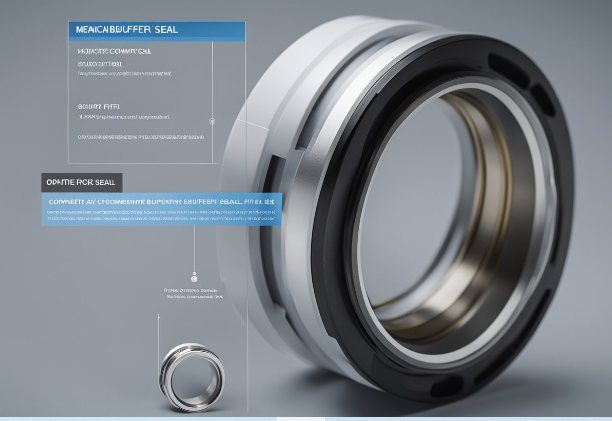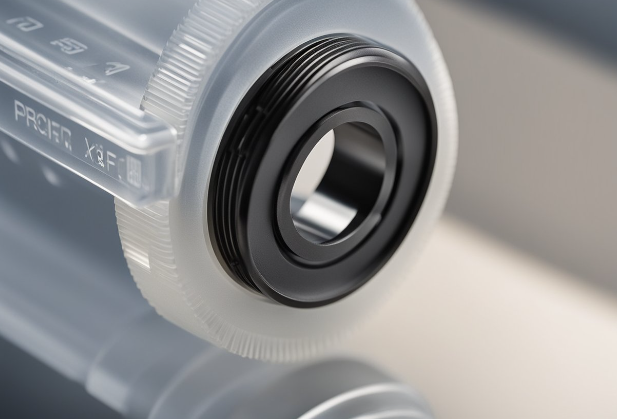PTFE Compact Buffer Seal: A Comprehensive Guide
If you are in need of a high-performance piston seal that can handle the high pressure and pressure spikes associated with high-performance systems, a PTFE compact buffer seal may be the solution you are looking for. This type of seal is designed to protect the primary rod seal from damage caused by high pressure spikes, while also preventing pressure from building up between the buffer and the rod seal.
PTFE compact buffer seals are typically made up of a filled PTFE cap, an elastomeric T-shaped energizer, and rigid, positively actuated back-ups. This design has also been used successfully in linear applications and offers excellent performance in a wide range of operating conditions.
When selecting a PTFE compact buffer seal, it is important to consider factors such as temperature, pressure, and chemical compatibility. Consulting with a seal manufacturer or supplier can help you select the right seal for your specific application. With the right PTFE compact buffer seal in place, you can enjoy optimal performance and protection for your high-pressure system.
PTFE Compact Buffer Seal Overview
Definition and Function
A PTFE Compact Buffer Seal is a type of seal used in hydraulic and pneumatic systems to prevent fluid leakage between moving parts. The seal is designed to fit tightly around a piston rod or shaft, creating a barrier that prevents fluid from escaping the system.
The function of a PTFE Compact Buffer Seal is to protect the system from contamination by preventing dirt, dust, and other particles from entering the system. This helps to extend the life of the system and improve its overall performance.
Material Properties
PTFE (Polytetrafluoroethylene) is the primary material used to make Compact Buffer Seals. PTFE is a high-performance polymer that is known for its excellent chemical resistance, low friction, and high temperature resistance.
PTFE Compact Buffer Seals are designed to withstand extreme temperatures, ranging from -328°F to 500°F (-200°C to 260°C), making them suitable for use in a wide range of applications. PTFE also has excellent resistance to chemicals, making it an ideal material for use in harsh environments.
In addition to its chemical and temperature resistance, PTFE is also a self-lubricating material, which helps to reduce friction and wear in the system. This can help to extend the life of the seal and improve the overall performance of the system.
Overall, PTFE Compact Buffer Seals are a reliable and durable solution for preventing fluid leakage in hydraulic and pneumatic systems. Their excellent material properties make them suitable for use in a wide range of applications, from aerospace and automotive to industrial and medical.
Design Considerations

When designing a PTFE compact buffer seal, there are several important considerations to keep in mind. These include dimensional standards and pressure ratings.
Dimensional Standards
PTFE compact buffer seals are available in a range of standard sizes and dimensions to fit various applications. The most commonly used sizes are based on industry standard dimensions such as AS568, JIS, and ISO. These standard sizes make it easy to select the appropriate seal for your application and ensure compatibility with other components in your system.
Pressure Ratings
PTFE compact buffer seals are designed to withstand a range of pressures depending on the specific design and material selection. The pressure rating of a seal is typically determined by the maximum pressure that the seal can withstand without experiencing permanent deformation or failure. It is important to select a seal with a pressure rating that is appropriate for the specific application to ensure reliable and safe operation.
When selecting a PTFE compact buffer seal, it is important to consider both the dimensional standards and pressure ratings to ensure that the seal is compatible with your system and capable of withstanding the intended operating conditions. By carefully considering these factors, you can select a seal that will provide reliable and long-lasting sealing performance in your application.
Application Scenarios
Industrial Usage
If you are looking for a reliable and durable seal for your industrial application, PTFE compact buffer seals are a great choice. These seals are designed to withstand harsh environments and extreme temperatures, making them ideal for use in a wide range of industrial settings.
One common application for PTFE compact buffer seals is in the chemical processing industry. These seals can be used to prevent leaks and contamination in pumps, valves, and other equipment that comes into contact with corrosive chemicals.
PTFE compact buffer seals are also commonly used in the food and beverage industry. These seals are FDA compliant and can be used in food processing equipment to prevent contamination and ensure the safety of the food being produced.
Hydraulic Systems
If you are looking for a seal for your hydraulic system, PTFE compact buffer seals are an excellent choice. These seals are designed to withstand high pressures and temperatures, making them ideal for use in hydraulic cylinders and other hydraulic equipment.
One of the key benefits of PTFE compact buffer seals is their ability to reduce friction and wear in hydraulic systems. This can help to extend the life of your equipment and reduce maintenance costs over time.
In addition to their durability and reliability, PTFE compact buffer seals are also easy to install and maintain. With proper installation and maintenance, these seals can provide long-lasting performance and help to keep your hydraulic system running smoothly.
Installation Guidelines

Installing a PTFE compact buffer seal is a straightforward process that requires careful attention to detail. Here are some guidelines to follow to ensure a successful installation:
1. Inspection
Before installation, carefully inspect the seal for any damage or defects. Check for any cracks, chips, or deformities that could affect the seal's performance. If you notice any issues, do not proceed with the installation and contact the manufacturer for a replacement.
2. Cleaning
Clean the seal and the shaft thoroughly before installation. Use a lint-free cloth and a mild solvent to remove any dirt, debris, or oil. Ensure that the shaft is dry before proceeding with the installation.
3. Lubrication
Apply a small amount of lubricant to the shaft to facilitate the installation process. Use a lubricant that is compatible with the seal material.
4. Installation
Carefully slide the seal onto the shaft, ensuring that it is aligned properly. Use a seal installation tool to press the seal into place. Be sure not to damage the seal during installation.
5. Testing
After installation, test the seal to ensure that it is functioning properly. Check for any leaks or abnormal wear. If you notice any issues, contact the manufacturer for assistance.
By following these guidelines, you can ensure a successful installation of your PTFE compact buffer seal.
Maintenance and Troubleshooting
Maintaining your PTFE compact buffer seal is essential to ensure optimal performance and longevity. Here are some tips to help you maintain your seal:
- Regular inspection: Regularly inspect your PTFE compact buffer seal for signs of wear, damage, or extrusion. If any issues are detected, it's important to replace the seal promptly.
- Proper installation: Ensure that the seal is installed correctly and that all components are in the proper position. Refer to the manufacturer's instructions for guidance.
- Lubrication: Proper lubrication can help extend the life of your seal. Use a compatible lubricant and apply it according to the manufacturer's recommendations.
- Cleaning: Keep your seal clean and free of debris. Use a compatible cleaning agent and follow the manufacturer's instructions.
If you encounter any issues with your PTFE compact buffer seal, here are some troubleshooting tips:
- Leakage: If you notice fluid leaking from the seal, it may be due to a damaged or worn seal. Check for damage and replace the seal if necessary.
- Excessive wear: If your seal is wearing out too quickly, it may be due to improper installation, lack of lubrication, or an incompatible operating environment. Address these issues to extend the life of your seal.
- Poor performance: If your seal is not performing as expected, it may be due to an incorrect seal size, improper installation, or an incompatible operating environment. Check these factors and make adjustments as necessary.
By following these maintenance and troubleshooting tips, you can help ensure the optimal performance and longevity of your PTFE compact buffer seal.

